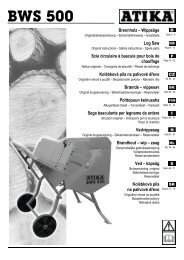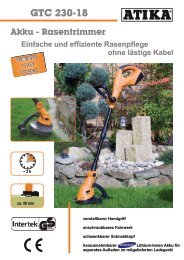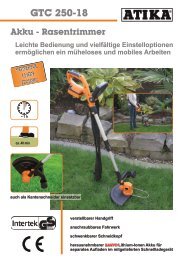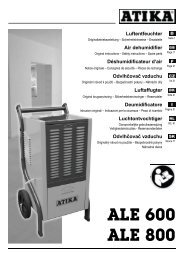Create successful ePaper yourself
Turn your PDF publications into a flip-book with our unique Google optimized e-Paper software.
� What type of logs can I split?<br />
Size of logs<br />
Length: max. 1300 mm<br />
Diameter: min. 120 – max. 400 mm<br />
The log diameter is a recommended guideline figure,<br />
because thin logs can be difficult to split if they contain knots<br />
or if the fibres are too strong.<br />
Do not try to split green logs. Dry logs are much easier to<br />
split, and do not cause jams as often as green (damp) wood.<br />
Operation<br />
Two-hand operation<br />
Never operate the log splitter with two people.<br />
Never block the control handles (clamping claws).<br />
1. Start the motor. Wait a few moments until the motor has<br />
reached its operating revolutions and the required<br />
pressure has been built up in the hydraulic pump.<br />
� At temperatures below –5° C, let the log splitter run<br />
for at least 15 min. in neutral to heat up the oil.<br />
2. Place the log on the log splitter table.<br />
� Only split the logs in the direction of the wood fibres.<br />
3. Hold the log tight with the clamping claws.<br />
4. Press both operating handles down simultaneously:<br />
� The splitting blade falls down and splits the log.<br />
5. Release the two control handles, the splitting blade<br />
returns to its initial position.<br />
� If you only release one control handle, then the<br />
splitting blade remains where it is.<br />
� Special instructions for splitting logs:<br />
� Preparations:<br />
The logs to be split should be<br />
cut to the maximum<br />
dimensions. Ensure also that<br />
the logs are cut straight and<br />
square.<br />
Place the log properly on the<br />
log splitter, so as not to<br />
cause any risk of stumbling<br />
or falling to the operator.<br />
� Adjusting the stroke height<br />
In case of shorter wood pieces the efficiency can be<br />
increased by shortening the return of the splitting cutter.<br />
1. Place the log on the splitting table and press the two<br />
control handles to bring the splitting blade down to<br />
approx. 2 cm above the log.<br />
2. Release one control handle so that the blade stays in this<br />
position.<br />
3. Release the second control handle.<br />
4. Shorten the return path at the rod fitted to the side by<br />
fixing the holding screw at the necessary height.<br />
Holding screw<br />
� Adjusting the table height<br />
Upper table plate position for logs up to 590 mm.<br />
Middle table position for logs up to 900 mm.<br />
Lower base position for logs up to 1300 cm.<br />
1. Split logs up to 590 mm on the table plate.<br />
Secure the table plate using the locking bolt.<br />
(The locking bolt engages in the table plate hole.)<br />
2. Split logs up to 900 mm on the table. Pull out the table<br />
plate.<br />
3. Split logs up to 1300 mm on the base. Press the locking<br />
lever down and swing aside the table.<br />
31


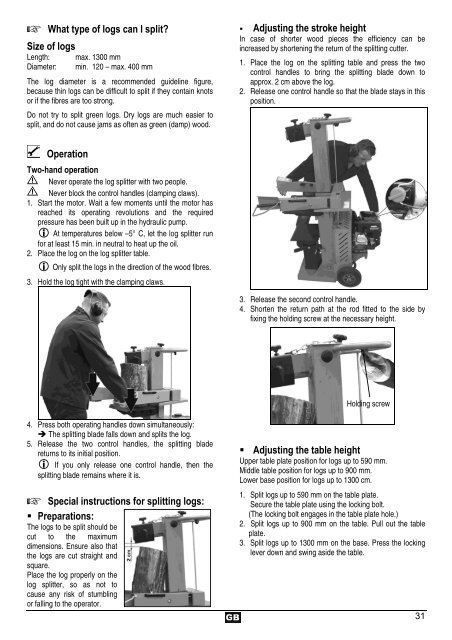
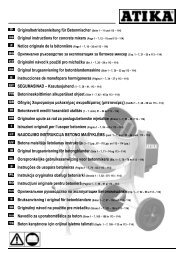
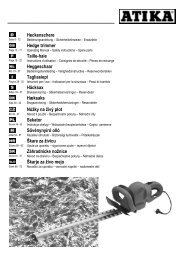
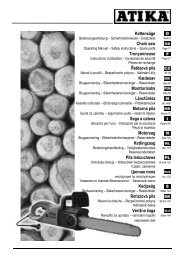
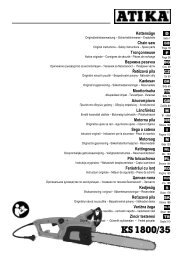
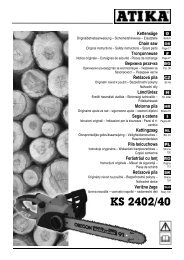
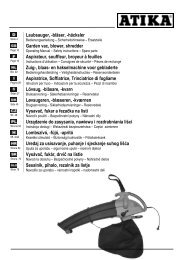
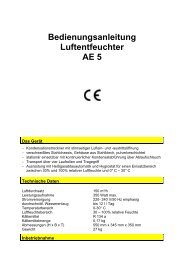
![BWS 400 AT] Km - Atika](https://img.yumpu.com/4285119/1/184x260/bws-400-at-km-atika.jpg?quality=85)
![BWS 600/ BWS 700 AT] KB? - Atika](https://img.yumpu.com/4285108/1/182x260/bws-600-bws-700-at-kb-atika.jpg?quality=85)
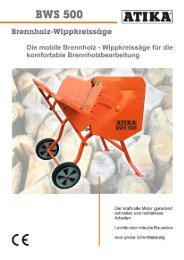
![BWS 400 AT] Km - Atika](https://img.yumpu.com/4285087/1/185x260/bws-400-at-km-atika.jpg?quality=85)
